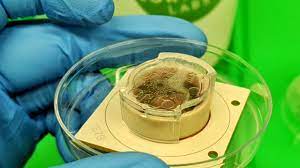Melbourne, Oct 13: Scientists have grown 800,000 brain cells in a lab that they say have learned to play the 1970s tennis-like video game, Pong.
The research, published recently in the journal Neuron, has for the first time shown that brain cells living in a dish can perform goal-directed tasks.
The team, including researchers from Monash University, RMIT University, University College London and the Canadian Institute for Advanced Research are now going to find out what happens when their DishBrain is affected by medicines and alcohol.
To conduct the experiment, the researchers took mouse cells from embryonic brains as well as some human brain cells derived from stem cells and grew them on top of microelectrode arrays that could both stimulate them and read their activity.
Electrodes on the left or right of one array were fired to tell Dishbrain which side the ball was on, while distance from the paddle was indicated by the frequency of signals.
Feedback from the electrodes taught DishBrain how to return the ball, by making the cells act as if they themselves were the paddle, the researchers said.
“We have shown we can interact with living biological neurons in such a way that compels them to modify their activity, leading to something that resembles intelligence,” said study lead author Brett Kagan, Chief Scientific Officer of Melbourne-based biotech start-up Cortical Labs.
“DishBrain offers a simpler approach to test how the brain works and gain insights into debilitating conditions such as epilepsy and dementia,” said Hon Weng Chong, Chief Executive Officer of Cortical Labs.
While scientists have for some time been able to mount neurons on multi-electrode arrays and read their activity, this is the first time that cells have been stimulated in a structured and meaningful way.
“In the past, models of the brain have been developed according to how computer scientists think the brain might work,” Kagan said.
“That is usually based on our current understanding of information technology, such as silicon computing. But in truth we don’t really understand how the brain works,” said Kagan.
By building a living model brain from basic structures in this way, scientists will be able to experiment using real brain function rather than flawed analogous models like a computer.
The researchers, for example, will next experiment to see what effect alcohol has when introduced to DishBrain.
“We’re trying to create a dose response curve with ethanol — basically get them ‘drunk’ and see if they play the game more poorly, just as when people drink,” said Kagan.
That potentially opens the door for completely new ways of understanding what is happening with the brain, the researchers said.
“This new capacity to teach cell cultures to perform a task in which they exhibit sentience — by controlling the paddle to return the ball via sensing — opens up new discovery possibilities which will have far-reaching consequences for technology, health, and society,” said Adeel Razi, director of Monash University’s Computational & Systems Neuroscience Laboratory.
The findings also raise the possibility of creating an alternative to animal testing when investigating how new drugs or gene therapies respond in these dynamic environments.
“We have also shown we can modify the stimulation based on how the cells change their behaviour and do that in a closed-loop in real time,” said Kagan. (PTI)
Trending Now
E-Paper


